Index Interviews Audio File History Time Line Photo Gallery SDPB
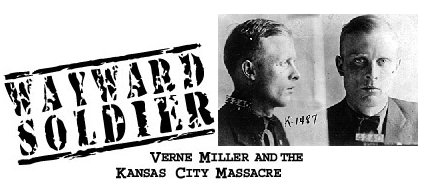
The Kansas City Massacre June 17, 1933 Controversy still surrounds the Kansas City Massacre that left five men dead. Historians disagree on the identity of Verne Miller's accomplices. The FBI identified Charles "Pretty Boy" Floyd and Adam Richetti as the other gunmen. Other names put forth include Harvey Bailey, Maurice Denning, Solly Weissman, Wilbur Underhill, Bob Brady, and Jack Griffin. Even the motives of the Massacre are disputed. Many say Miller was trying to rescue a friend, convicted killer and robber Frank Nash. Others say the event, which resulted in Nash's death, was a gangland hit.
June 17, 1933, was a sad day for Kansas City's Union Station. It was an active, thriving landmark and centerpiece. However, at about 7:20 a.m., the station became an "arena of horror," according to Kansas City's newspaper, The Star.
Events leading to the massacre began the day before, when escaped convict Nash was taken into custody in Hot Springs, Ark., by Frank Smith and Joe Lackey, both agents of the Bureau of Investigation, which later became the FBI. They were assisted by Otto Reed, Police Chief in McAlister, Okla.
They escorted Nash to Kansas City by train, where he was to be transported in the car of agent Raymond Caffrey to Leavenworth Penitentiary. With Caffrey were Bureau agent Reed Vetterli and two Kansas City detectives, W.J. Grooms and Frank Hermanson.
While the lawmen waited, three men stood by, armed with machine guns, ready to free Nash. The train arrived on schedule at 7:15 a.m. and Nash was immediately taken to Caffrey's car. According to the official FBI version of events, as the party was getting into the car, two men - possibly three - rushed forward. One shouted, "Up, up!" There was no time for the lawmen to reach for their weapons. The next order came quickly, "Let 'em have it!" The group fired r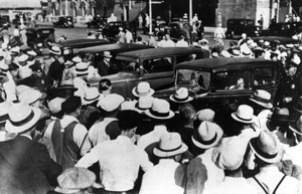 elentlessly with machine guns from all sides of Caffrey's car.
elentlessly with machine guns from all sides of Caffrey's car.
The result was truly a massacre. Hermanson and Grooms, exposed between the parked cars directly in the gunman's line of fire, were killed nearly instantly. Caffrey fell with a bullet in his brain and died before he reached a hospital. Vetterli, wounded slightly, dropped down and crawled to the back of the car. He crouched and sprinted for the safety of the station. In the agents' car, Reed was dead. Lackey took several bullets to the back and was paralyzed for life. Smith escaped unharmed after slumping to the floor and playing dead. Nash, slumped in the front seat, had his head blown apart and was the first to die in the Massacre.
After the gunfire stopped, a voice was heard, "They're dead. They're all dead. Let's go."
Soon, Verne Miller, "Pretty Boy" Floyd and Adam Richetti were named as chief suspects in the violent massacre.
The massacre triggered dramatic changes in the Bureau, then a relatively small agency called the Division of Investigation, composed of investigators without the authority to carry firearms or make arrests. A young J. Edgar Hoover did not miss the opportunity created by public outrage and the demand for more effective law enforcement.
Less than a year later, President Franklin Roosevelt signed into law several statutes increasing the Bureau's jurisdiction. A month later, agents were given power of arrest and authority to carry firearms at all times. The agency, renamed the Federal Bureau of Investigation (FBI) on July 1, 1935, was given the mandate, power, and tools to fight gangster crime.
Six months after the massacre, Miller was murdered by fellow mobsters in Detroit. In October 1934, "Pretty Boy" Floyd was killed by FBI Agents on a farm in Ohio. Adam Richetti was arrested in 1934 and, after a trial and conviction for murder, was executed in the gas chamber at the Missouri State Penitentiary.
Today, the Kansas City Massacre remains part of our country's history, But, locals say visitors to the Union Station in Kansas City can still find bullet holes in the station's east entrance - an enduring memorial to the tragedy of June 17, 1933.
Verne
Miller In the beginning, South Dakota's papers lauded his credibility as a war hero and law enforcement official. Only 13 years later, a nationwide search was under way and he was deemed "the most dangerous criminal in the country.
"Verne Miller was a complex character. Even his early life is surrounded by mystery. He even obscured his birthday, listing 1892, 1895 and 1896 and his birthplace as South Dakota, Iowa or Illinois.
No one quite understands why this good guy went bad. What is known, is that Miller was a victim of divorce and was left on his own at an early age. By age of 10, he had dropped out of school. In 1914, he moved to Huron and began working as a mechanic. He joined the Army in 1916 and served on the Mexican border until 1917 when he returned to Huron and married. A month later, he left for France with the military service.
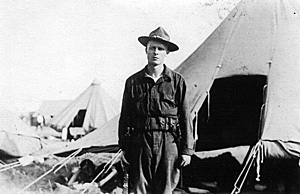
Color Sgt. Verne Miller returned a hero, claiming decorations for being a marksman and sniper and receiving a French Croix de Guerre award for bravery. After his return, he joined the Huron city police force where he worked until 1920, when he resigned. By then, his name was on the ballot as the Republican candidate for Beadle County Sheriff. He won by 41 votes.
The community was pleased with his service and Miller was on his way to re-election when his wife, Mildred, fell ill and was rushed to a Rochester, Minn., hospital. Taking a short leave, Miller went to visit his wife - and never returned. Deputies discovered $6,000 missing from the county fund and a criminal was born.
A three-month search ensued, ending when a St. Paul, Minn., hotel clerk turned him in. Miller pled guilty to embezzling $2,600 in county funds and served two years in the South Dakota penitentiary. While there, he landed a cushy position as the warden's chauffeur and passed his time driving the warden around Sioux Falls. Paroled in 1924, he worked as a farmhand until his parole terms were satisfied. He left in search of new pursuits but was indicted for bootlegging, a crime for which be posted bond. He then left South Dakota.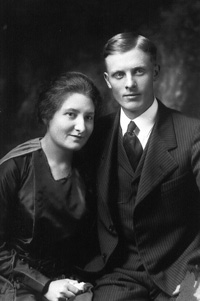
Shortly after leaving Sioux Falls, Miller met Vivian Gibson, an attractive, young farm girl from Leola, S.D. From 1926-1929, Miller and Gibson were leading bootleggers in the Twin Cities and were known for their top-notch casino operations in Montreal, Canada. In 1930, he jumped from bootlegging to bank robbing when he joined criminals such as Harvey Bailey, Tommy Holden, Jimmy Keating, Frank Nash, "Machine Gun" Kelly and others. Over the years, this gang would be responsible for numerous bank holdups from the Dakotas to Texas. On Dec. 16, 1932, he was part of the crew and drove the getaway car for the infamous Barker gang when they held up the 3rd Northwestern Bank of Minneapolis. Two patrolmen, who happened on the scene, were killed by a hail of machine-gun fire. The gang split up and Miller moved to Kansas City to cool off.
Only a few months later, Miller received a call telling him that his good friend Frank Nash had been arrested and authorities were transporting him to prison. That phone call led to the bloody rescue attempt that left five men dead and became known as the Kansas City Massacre.
U.S. Attorney General Homer Cummings declared the massacre "a challenge to the government. The army of crime has declared war on the United States." Within two weeks, Miller was named as the leader of the Kansas City Massacre gang. No stone went unturned while the FBI searched for Miller.
Miller left Kansas City immediately and fled to New York while Vi Gibson hid in Chicago. In October 1933, FBI agents located her apartment just one day before Miller appeared at the door. He managed to escape through a flurry of bullets. With lawmen and members of the criminal underworld after him, his days were numbered.
On Nov. 29, 1933, a motorist traveling outside of Detroit discovered a mutilated, naked body alongside the road. Fingerprints taken confirmed that Miller's days were over.
News of his death was met with a mixture of emotions in South Dakota. The Evening Huronite reported that the citizens of Miller's hometown "refused to remember his reputation of a life of crime and grieved the Verne Miller, fearless sheriff and valiant soldier they knew." His wife Mildred, though legally separated since 1929, stuck by him saying, "I don't believe all the things they say about Verne. Because he became involved in a few scrapes nearly every major crime in the country was laid to him. He was wonderful to me and I have nothing against him."
His father made plans for the funeral. Miller, a veteran and American Legion member, was entitled to full military rites. However, the national American Legion forbid the Huron post from participating. His father's hometown of White Lake held the memorial service with full military rites. Miller's flag-draped casket was then escorted from White Lake to Huron by uniformed ex-servicemen, Miller's friends. There, following a ceremony for an overflow crowd, Verne Miller was put to rest.
Click bar to see : Official Statement Prison Sentence Parole Report Governor's Release
Charles
Arthur "Pretty Boy" Floyd
Born on Feb. 3, 1904, to a farm couple, Charles Arthur Floyd was like any other child - a good kid who rarely got in trouble. His family moved when he was 7 to an Oklahoma farm where he grew up like any other farm kid at the time. His good kid image wouldn't stick for long. In 1919, he set off to the harvest fields of Kansas and Oklahoma to try his hand at "hard work." Unfortunately, these crews contained drifters, looking to earn a buck between seasons of carousing. Choc - a nickname he received because of his love for choctaw beer - learned how to fight, kick and gouge from these vagabonds.
When Floyd was 20, a local woman captured his heart and quickly became his bride. They bought a house and a baby came shortly thereafter, Charles Dempsey Floyd. The elder Floyd kept the family tradition, working hours in the fields. Soon, he became discouraged, knowing he wanted more out of life than hours of work and little pay. John Hilderbrand, a thief hiding from the police, met Floyd and boasted how he robbed a manufacturing company of $1,900 and would like Floyd to help with thefts of this nature. In August 1925, he kissed his 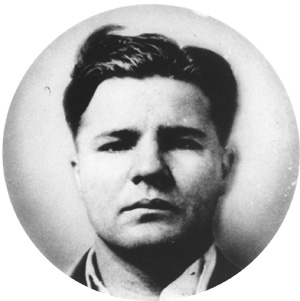 wife and boy and began his career as an outlaw. By the end of August, they robbed a half-dozen food stores and service stations, netting about $565.
wife and boy and began his career as an outlaw. By the end of August, they robbed a half-dozen food stores and service stations, netting about $565.
In the early days of September, the crew held up a food store and grossed several thousand dollars in cash. Days later, the thieves bought a new Studebaker and cruised the streets, where they were quickly recognized and arrested. Floyd served five years. During his trial, Floyd received a new nickname. When the clerk described the robbers, Floyd was "a mere boy - a pretty boy with apple cheeks" - a name he hated.
Two months before Floyd was released from prison, his wife filed for divorce. When he was released on March 7, 1929, he made a beeline for Kansas City. From there, he continued his life of crime. He met Beulah "Juanita" Baird and they became lovers.
A year after his release, Floyd was caught for robbery in Ohio and was sentenced to 15 years in prison. En route to the penitentiary at Columbus, Floyd talked his guards into uncuffing him so he could use the restroom. Floyd escaped and returned to Kansas City. After reuniting with Juanita, he looked up William Miller (a.k.a. Billy the Baby Face Killer.) The two men planned a series of bank jobs in the East and South. The duo was short lived. The law caught up with the group in Toledo, Ohio. Miller died in the shootout and Juanita was seriously injured. Floyd escaped with several shots to his abdomen. A reward of $6,000 was put up for the capture of Charles Arthur Floyd, dead or alive.
Floyd missed his wife and son and decided in 1931 to reacquaint himself with his family. His wife had remarried, but when Floyd showed up, she fell in love with him again and the Floyds disappeared to Fort Smith, Ark. where they adopted the alias of Mr. and Mrs. Charles Douglas. Soon, the family moved to Tulsa, to take advantage of the better school system. But, trouble loomed. Residents questioned the mysterious couple and the man that resembled "Pretty Boy" Floyd. Finally, the day came when, acting on a tip from a neighbor, the police searched their home in February 1932. The family fled on foot - his wife and son to a bus station and Floyd to Cookson Hills. His wife and son were caught, but were released soon after.
The Kansas City Massacre on June 17, 1933, would eventually lead to his death nearly a year later. Following the Massacre, the FBI - now incredibly strong with the passing of the Fugitive Felon Act - searched religiously for this dangerous criminal. Along with his sidekick, Adam Richetti, Floyd fled to Buffalo, N.Y., and settled under an alias. The two set up housekeeping with Rose and Juanita Baird. Topping the FBI wanted list was bank-robber John Dillinger, followed by "Pretty Boy" Floyd. In October 1934, Dillinger died and Floyd was named Public Enemy Number One. The FBI vowed Floyd would be dead before Christmas and put Melvin Purvis, the man who shot Dillinger, in charge of bringing Floyd down.
Floyd figured there was one way out - leave the country for Mexico. He would first return to Oklahoma to say goodbye to family and friends. On the way there on Thursday, Oct. 18, the car slid into the ditch in Ohio. Floyd and Richetti hid in the greenwood while Juanita and her sister Rose traveled to town for repairs. Meanwhile, the police stumbled on Floyd and Richetti. Richetti darted from the brush and Floyd fired his gun. Floyd escaped to the forest beyond while Richetti was caught.
Marvis Purvis was notified immediately and FBI agents combed the area. Bridges closed. Roadblocks appeared at all exits. Teams of dogs combed the areas where Floyd vanished. By Oct. 22, Floyd was tired and hungry. He stumbled on a farm house and a lady, who introduced herself as "Widow Condie" fixed him a meal. Later, her brother who introduced himself as "Mr. Dyke," agreed to drive Floyd to Clarkson, the nearest town. Along the way, two cars halted when they drove past Floyd. He knew by the way the faces looked his way, it meant trouble. Purvis and his agents were in the first car; the four East Liverpool policemen were in the following. people in two cars spotted "Pretty Boy" Floyd. Floyd leapt from his car and set out on foot. A shot was fired and hit Floyd in the right arm and threw him to the ground. He got up and continued to run. Purvis then fired the fatal shot.
After his death, Floyd was shipped to Cookson Hills. More than 20,000 attended his funeral.
Adam "Eddie" Richetti
The only man ever convicted for the slayings of the Kansas City Massacre, Adam "Eddie" Richetti was known for his reputation as a bank robber and as "Pretty Boy" Floyd's partner.
He grew up in a large family. His parents were immigrants from Italy who settled in Coal County near Lehigh in the coal-mining district of south-central Oklahoma.
To keep the pasta, beans, and garlic in the cupboard, Richetti's parents hawked bottles of hearty choc beer, the miners' preferred beverage. They also picked up bits of coal and sold them to poor families for winter fuel.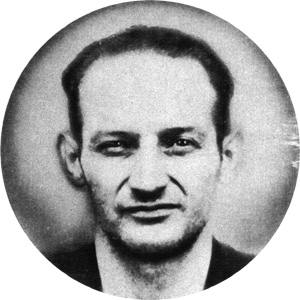
Richetti ventured forth as a professional criminal in his late teens. He began his criminal career with an arrest in Hammond, Ind., on Aug.7, 1928, for a holdup. He was sentenced to from one to ten years in the State Reformatory in Pendleton, Ind., and was paroled on Oct. 2, 1930. His next arrest occurred on March 9, 1932, at Sulphur, Okla., for bank robbery. He subsequently served a sentence at the State Penitentiary, McAlester, Okla., from April 5, 1932, to Aug. 25, 1932, when he was released and placed on bond, which he forfeited. Richetti was sought for jumping the $15,000 bond, and for a Tishomingo, Okla., robbery.
After fleeing from the Kansas City Massacre, Floyd and Richetti made their way to Toledo, Ohio, where they met Beulah, also known as Juanita, and Rose Baird in early September 1933. From there, the four traveled to Buffalo, N.Y. On Sept. 21, 1933, Floyd and Juanita, using the names of Mr. and Mrs. George Sanders, and Richetti and Rose Baird, using the names Mr. and Mrs. Ed Brennan, rented an apartment. The occupants of the apartment building considered the couples mysterious, as they seldom left the apartment. In October 1934, they decided to flee to Mexico; but first, the couples were going to stop in Oklahoma. They bought a Ford sedan and headed west.
The trip began Oct. 20. Hours later, near Wellsville, Ohio, they skidded into a telephone pole. Floyd and Richetti remained on the outskirts of the town, while Rose and Beulah Baird took the damaged car into a garage for repairs. The Wellsville, Ohio, Police Chief, J. H. Fultz, following up on reports that suspicious-looking men were seen outside of town found the two resting in a wooded tract of land. A gun battle ensued. Chief Fultz apprehended Richetti. Floyd escaped, but was soon tracked down and shot to death.
Richetti was convicted on circumstantial evidence and sentenced to death for the killing of Kansas City police detective Frank Hermanson, who probably was shot accidentally by the same federal agent who killed prisoner Frank Nash in the Kansas City Massacre. Richetti died in the gas chamber of the Missouri State Prison on Oct. 7, 1938, protesting to the end that he was innocent. He claimed he stayed up all night drinking and was too hung over to participate in the Kansas City Massacre.
Frank
"Jelly" Nash Born in the small town of Birdseye, Ind., on Feb. 6, 1887, Frank Nash had a hard life from the start. His mother died when he was two and a cast of relatives took turns raising him. In 1902, his father, John, opened the Nash Hotel in Hobart, Okla., and sent for his son to help operate his new business. After only two years, Nash left to join the Army.
When he returned three years later, he worked as a hotel handyman and cook, but spent most of his time listening to tales from the travelers. With an affinity for fine things and a strong dislik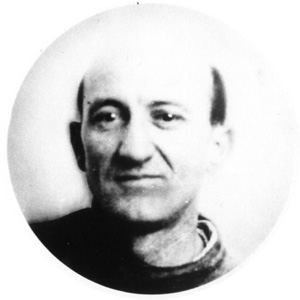 e of hard work, Nash ran out of income and began to pay for his worldly goods by robbing stores. In May of 1911, he was arrested for burglarizing a store. He was arrested six moretimes in six months, none of which resulted in a conviction.
e of hard work, Nash ran out of income and began to pay for his worldly goods by robbing stores. In May of 1911, he was arrested for burglarizing a store. He was arrested six moretimes in six months, none of which resulted in a conviction.
In 1913, Nash's accomplice, Nollie Wortman, was found dead near Hobart. Nash was charged with his death and found guilty of murder and was sentenced to life in prison at the Oklahoma State Penitentiary in McAlester. Nash talked his way into a parole so he could do his part in the war effort. He was then given a full pardon after the war.
Nash didn't learn his lesson in prison the first time around and in October 1919, he was arrested and convicted for robbing a bank and sentenced to 25 years. During his stay at the state penitentiary, he met Al Spencer, a member of the Henry Starr gang. In 1922, Spencer escaped. Soon, Nash received 60-days leave for "business reasons." His business - robbing banks. He didn't return. In the 20 months following, Spencer's gang robbed somewhere between 20 and 40 banks. Nash was there for many of them.
After the Katy Limited train robbery, a massive manhunt for the Spencer gang ensued. Within a month, every member except Nash was dead or in custody. Nash escaped to Mexico until U.S. Marshals lured him back to the States where he was promptly arrested. He arrived at the federal penitentiary in Leavenworth, Kan., to serve 25 years for assaulting a U.S. Mail custodian.
On Oct. 19, 1930, Nash picked up his favorite book, The Complete Works of William Shakespeare, from the prison library and simply walked out of prison. He headed for the criminal haven of St. Paul, Minn. It was here that Nash became close with Verne Miller. In May 1933, Nash wed Frances Luce in Hot Springs, Ark.
While at a horse race in Hot Springs on June 16, 1933, Nash was arrested. The lawmen caught the evening train for Kansas City. The train would arrive at Kansas City's Union Station at 7 a.m., Saturday, June 17, 1933. Devastated by his arrest, Frances Nash asked Miller for help with freeing her husband. What followed became known to the world as the Kansas City Massacre - an ill-fated escape attempt that resulted in Nash's death.
Learn More About
Verne Miller, His Cohorts and the Kansas City Massacre
· Books
Callahan, Clyde C., and Byron B. Jones. Heritage of an
Outlaw - The Story of Frank
Nash.
Hobart, Okla.: Schoonmaker, 1979.
Clayton, Merle. Union Station Massacre. New York: Bobbs-Merrill, 1975.
Cooper, Courtney Ryley. Ten Thousand Public Enemies. Boston: Little, Brown, 1935.
Helmer, William. Public Enemies: America's Criminal Past, 1919-1940. New York: Checkmark Books, 1998.
Huss, Dorothy, Robert S. Kuni, William Lampe, and Margaret Moxon. Huron Revisited. Huron, SD: East Eagle, 1988.
King, Jeffrey S. The Life and Death of Pretty Boy Floyd. Kent, Ohio: Kent State Univ. Press, 1998.
Louderback, Lew. The Bad Ones: Gangsters of the '30s and Their Molls. Greenwich, Conn.: Fawcett, 1968.
Lowenthal, Max. The Federal Bureau of Investigation. New York: William Sloane, 1950.
Maccabee, Paul. John Dillinger Slept Here: A Crook's Tour of Crime and Corruption in St. Paul, 1920-1936. St. Paul: Minnesota Historical Press, 1995.
Potter, Claire. War
on Crime: Bandits, G-Men, and the Politics of Mass
Culture. Piscataway, NJ:
Rutgers University Press, 1998.
Poulsen, Ellen. Don't Call Us Molls: Women of the John Dillinger Gang.
New York: Clinton Cook Publishing Corporation, 2002.
Smith, Brad. From Lawman to Outlaw: Verne Miller and the Kansas City Massacre. Bedford, Ind. Jona Books, 2002.
· Papers
and Publications
Federal Bureau of Investigation. Kansas City Massacre Files,
62-28915.
McPherson County, South Dakota Circuit Court. State of South Dakota vs. Stanley Mathis, 1922.
South Dakota State Penitentiary Prison Inmate Files. SD State Archives.
· Web sites
The FBI Files
http://foia.fbi.gov/floydsum.htm
http://kansascity.fbi.gov/massacre.htm
http://www.fbi.gov/libref/historic/famcases/floyd/floyd.htm
Sustik and Ricchetti Family
History
http://www.fortunecity.com/meltingpot/kuwait/55/index.htm
Court TV's Crime Library
http://www.crimelibrary.com/gangsters_outlaws/outlaws/index.html
Index Interviews Audio File History Time Line Photo Gallery SDPB